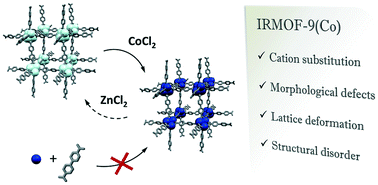MOF transmetalation beyond cation substitution: defective distortion of IRMOF-9 in the spotlight†
Abstract
The beneficial effects of transmetalation on MOFs' functional behaviours are well-known as it endows the material with novel functionalities. Even though the structural adaptation of the framework to the new metal ion has a great impact on the properties of the resulting material, this subject still remains poorly understood. Herein, we present a detailed structural study by single crystal XRD and scanning electron microscopy on the unprecedented Co-substituted form of a renowned MOF, namely IRMOF-9. The performed Zn-to-Co exchange induced profound changes in the microstructure of the crystals as well as in the framework arrangement. While the evaluation of the first suggests an unconventional transmetalation mechanism involving a phase demolition and re-growth process, the average coordination network shows a remarkable shrinking of the solid with a loss of ∼2.5% of its starting volume. This deformation comes with an increased exposure of the metal sites to the MOF cavities due to a more open disposition of the linkers, whose peculiar disorder agrees with such structural change. These results shed light on the complexity of IRMOF-9(Co), highlighting the importance of structural investigations in transmetalation studies.

- This article is part of the themed collection: Introducing the CrystEngComm Advisory Board and their research


 Please wait while we load your content...
Please wait while we load your content...